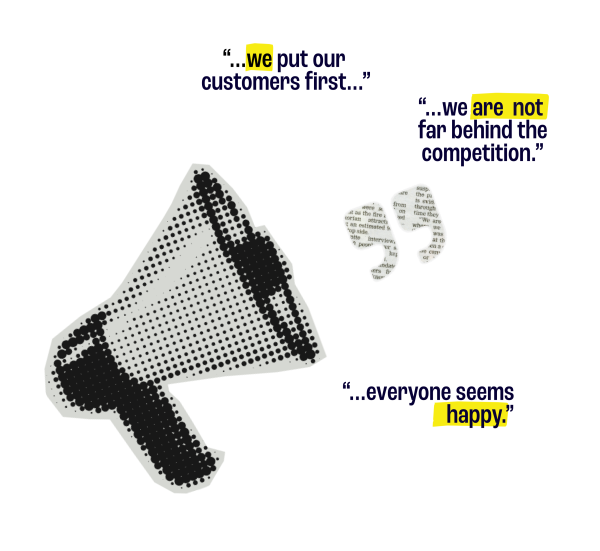As any agency you’ve worked with will tell you – it’s really important we spend time getting to understand everything we can about your brand – the landscape you operate in, the people you sell to, the competitors you lose to. And importantly, what the needs of your audience are that your product or service will help them with. There are many tried and tested tools to do this with – budget and timing allowing. But we’ve never found this very satisfying. The research often serves to reinforce what you already suspected, the interviews with the experts in the business feel lack-luster and scripted. It seems as though the same old truths are being uncovered time and again. And the same old lies are trotted out as business lore.
To make real change, you need listen more closely. Listen differently. Listen to the silence between the words.
We employ White Space Listening™ as both an ideology for the agency and as the sum of multiple tools and techniques (both widely available and proprietary) that allow us to dig deeper, dig differently and uncover hidden human insights. White Space Listening takes the idea that the real truth often exists in the gaps between what people say, and employs that philosophy across all the information gathering that we do.
While there are many amazing ways to gather information and data that build a picture of a brand in its environment, and put flesh on the bones of an audience persona – we recognised that to build real differentiation and lead our clients to become a more inspiring brand, we had to do something different. So we started to think about the gaps. In every conversation hundreds of words spoken, but hundreds more are left unsaid. In every dataset, there are hundreds of relationships, but many more patterns left unexplored. In every brand experience, there are hundreds of touchpoints, but countless more emotional connections made. And so we focus on these gaps, the white space – and here is where we dig until we uncover something that others have missed.
Is this just another agency putting a new label on an old can? No way. We know that people are looking to brands to inspire them more than ever in this increasingly unpredictable world. And brands that inspire have the opportunity to grow faster, price more premium and sell more₁. Not only that, but we also know that people expect a brand’s values to align with their own (82% of shoppers) yet three quarters have also said they’ve shopped elsewhere when they’ve felt a conflict of values₂.
So the desire is there amongst consumers (both B2B and B2C) to enjoy inspiring brand touchpoints, to feel motivated by the businesses they buy from and to share values. And yet, so few businesses are delivering against this desire because it can be really hard to hear what inspiring, motivating, enjoyable, memorable really looks like for your customers.
White Space Listening helps you hear more.
Equally, we know that the path to genuine engagement needs to start with being customer-centric, people-centric. Lots of business talk the talk, but how many are truly, deeply customer-centric in every part of the business? Sometimes those difficult questions need to be asked. And White Space Listening allows us to peek behind the curtain.
When we were working with a financial compliance and risk services client who were looking to rename, rebrand and shake up the market, we had to dig deep to try and find the insight that would unlock a genuine human need for us to align with. Compliance is seen as a necessary yet mundane part of running a business that requires some level of financial capability. So how can you stand out and even draw in prospects to a service they view as a tick-box exercise?
It turns out it isn’t just that people see the red-tape of financial compliance as necessary but uninspiring – they actually feel it can curb their ambitions, visions and hopes for growth. Which isn’t true. Done well, it can actually feed the growth opportunities of a business.

And so we had our playground to start the creative thinking in.
Many years ago, the Australian travel industry was looking into how to tempt more UK travellers over for their traditional two week holidays. The initial research through up all the expected barriers – the flights were too expensive, the journey was too long to justify for a two-week break. But these concerns were countered, there was still a reluctance. Listening harder, it was revealed that the issue was really around expectations of what the country and culture was like. The real barrier was that British holidaymakers felt it was too far to go to end up somewhere just like home (only warmer). So the real solution was to campaign around the magnificent differences.
Leo Burnett created McDonalds’ “Raise your arches” campaign based on a hard-to-spot human insight that came out of the unspoken. Going for a Maccie Ds is naughty, you know you probably shouldn’t – but you also know there is something joyfully conspiratorial. You don’t ask someone out loud to come to McDonalds’ for lunch… you ask them on the QT with a raise of the eyebrows… conveniently (golden) arch shaped. That was the tic that they noticed in the research. And that ad - with all its human insight – is superb. Helped by a little nostalgic sound track of course.
The insights are there, and with them the opportunity to really understand your audience. By uncovering the previously unseen or ignored, we can start our creative thinking from a totally different viewpoint to everyone else. A different lens on a different view is something quite special. It allows us to create brand touchpoints for the human at the centre of every experience. So stop believing the lies you tell yourselves, and listen for the truth in the gaps in between.
Share this article
